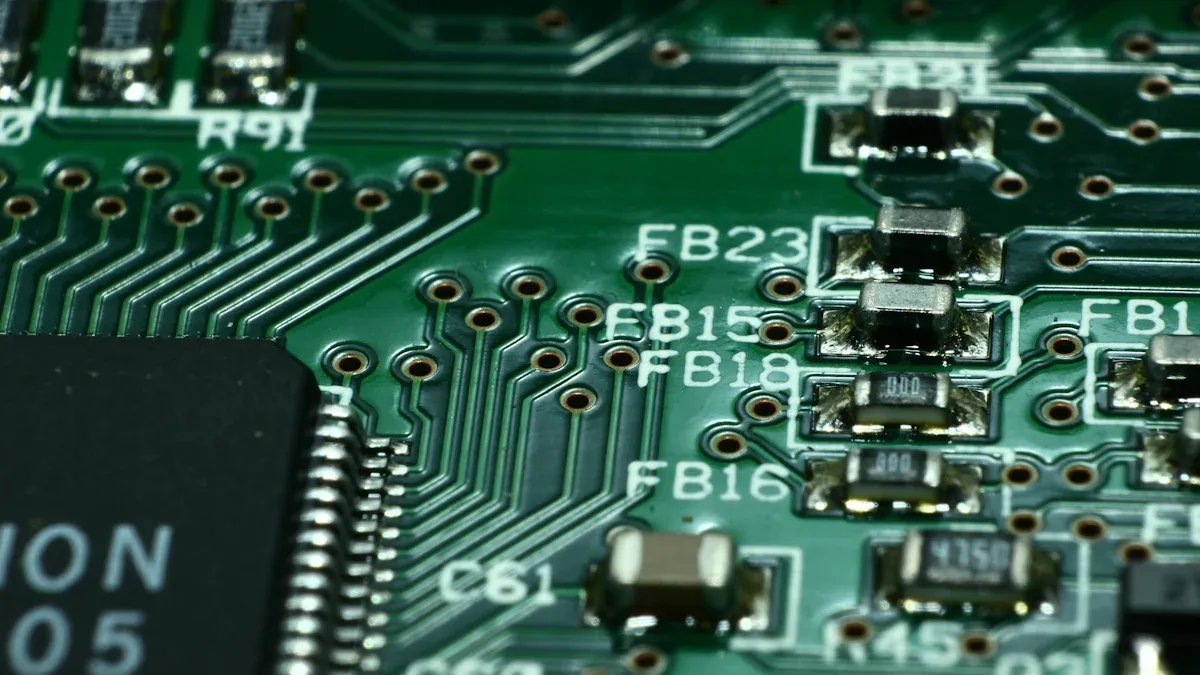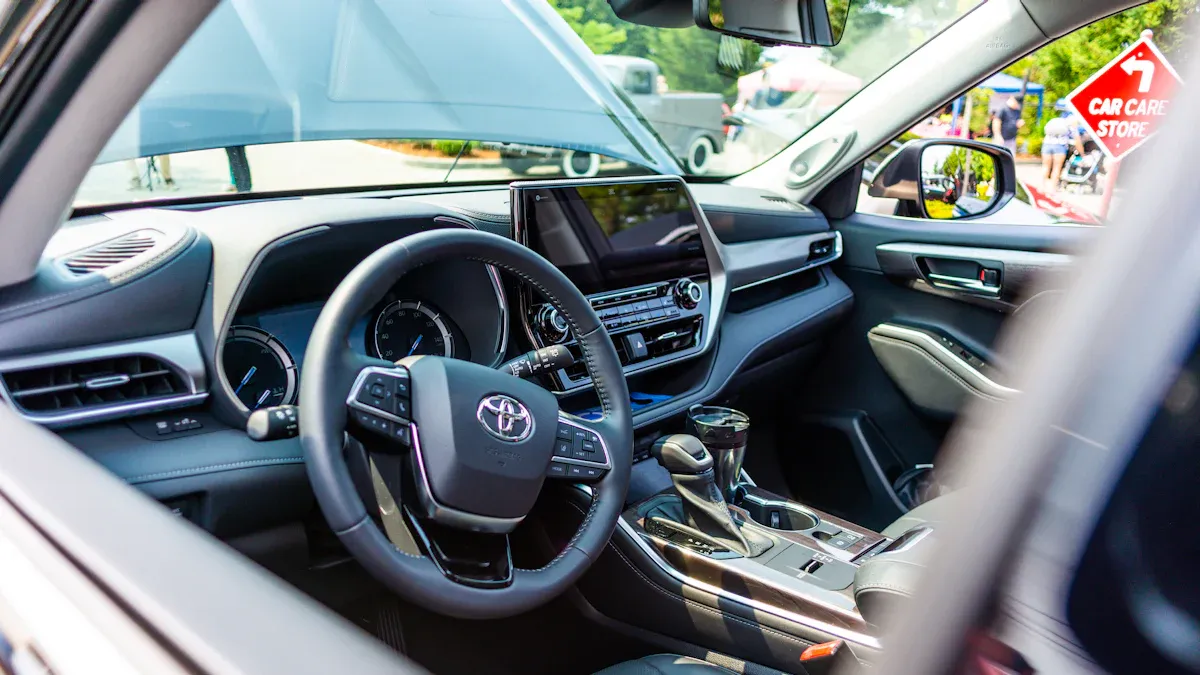SMT Board Assembly for Automotive Applications: Meeting Stringent Quality and Durability Standards

Automotive smt board assembly needs very high quality and reliability. It must also follow strict rules. Cars depend on strong pcb assembly, especially for self-driving electronics. LTPCBA uses new surface mount technology and careful process controls. These help smt assemblies during reflow, cleaning, and inspection. Mechanical testing checks that underfilled smt assemblies are tougher. This makes sure they meet rules and work well for a long time in cars.
Key Takeaways
Automotive SMT board assembly must follow strict rules for quality. This helps electronics work safely and last a long time in cars. Cars can have very tough conditions.
LTPCBA uses advanced machines and careful controls in their process. This helps them build strong and reliable boards. These boards meet or go beyond the rules for the automotive industry.
LTPCBA tests and tracks every step very carefully. This helps them make durable and high-quality assemblies. These assemblies help keep cars safe and running well.
Automotive Electronics Quality Standards
Key Industry Standards
Automotive electronics must follow tough quality rules. These rules keep cars safe and working for a long time. Companies use international standards to help with every step of smt pcb assembly. This starts with picking materials and ends with checking the finished product. These standards make sure each pcb assembly can handle rough car conditions. This includes electric and self-driving cars.
Standard / Certification | Description | Example |
|---|---|---|
ISO 7637-2 | Tests electrical transient immunity in vehicles | A headlight control module certified to ISO 7637-2 survives 100,000 load dump surges up to 40V and does not reset in -30°C winter engine starts |
AEC-Q100 | Qualification standard for integrated circuits in automotive environments | Voltage regulators certified to AEC-Q100 Grade 0 withstand temperatures from -40°C to +150°C and pass vibration and thermal cycling tests |
AEC-Q103 | Qualification for discrete sensors | Pressure sensors with AEC-Q103 certification maintain accuracy under years of vibration and temperature extremes in tire monitoring systems |
AEC-Q104 | Qualification for multi-chip modules | Power modules with AEC-Q104 certification handle heat from fast-charging electric vehicles without failure |
AEC-Q200 | Qualification for passive components | Resistors with AEC-Q200 certification resist breakdown in extreme cold or heat conditions |
ISO 16750 | Environmental testing standard for automotive electrical/electronic components | ECUs passing ISO 16750 endure freezing winters, desert heat, and prolonged vibration without failure |
ISO 26262 (ASIL levels) | Functional safety standard for automotive electronics | Braking control units certified to ASIL D have redundant processors cross-checking 100 times per second to prevent dangerous failures |
IPC-6012DA | PCB durability standard for automotive | PCBs meet strict durability requirements for automotive use |
IPC-A-610 | Quality rules for electronic assemblies | Ensures high-quality assembly of automotive electronics |
IATF 16949 | Automotive quality management system | Fuel injectors certified to IATF 16949 do not leak or clog before 150,000 miles due to statistical process control and 100% end-of-line testing |
These rules cover all parts of smt board assembly. They include process control, inspection, reflow, and traceability. For example, ISO 26262 has strong safety rules for self-driving and electric cars. AEC-Q100 and AEC-Q200 make sure parts can survive tough car environments. IPC-A-610 and IPC-6012DA focus on making sure pcb assembly is strong and lasts a long time.
Car makers use cloud tools to keep track of special car parts. Engineers sort parts by certifications like AEC-Q100, AEC-Q101, and ISO 26262 ASIL levels. This helps teams find parts that meet temperature and quality rules, like IATF 16949. It also helps them buy parts faster and follow the rules.
LTPCBA follows all these international standards. The company cares about quality and process control. Every smt pcb assembly meets or goes beyond what is needed for car electronics. LTPCBA uses traceability systems to track each pcb and part. They do this at every step, from assembly to inspection and reflow. This helps them follow the rules and makes customers trust their products.
Environmental and Reliability Challenges
Automotive electronics face some of the hardest conditions. Each smt pcb assembly must survive heat, cold, shaking, dirt, and other problems. These things can make electronics fail early. This is true for regular cars, electric cars, and self-driving cars. Safety features like airbags and brakes need perfect electronics.
Test Type | Test Conditions (JEDEC) | Failure Mechanisms Observed |
|---|---|---|
JESD22A104 | Cracking, delamination, fatigue failures | |
Vibration | JESD22-B103B | Solder joint failures, cracking, impact failures |
Contamination (HAST, PCT) | JESD22A118, JESD22A102 | Corrosion, delamination, migration, interface contamination |
Temperature cycling means the pcb gets hot and cold very fast. This makes materials grow and shrink. It can cause cracks and other damage in solder joints and boards. Vibration in cars causes cracks and breaks in solder joints. It can also make traces come loose, especially in smt assemblies. Dirt or leftover stuff from making the boards can cause corrosion and electrical problems. That is why cleaning and checking are very important.
Vibration in cars causes cracks in solder joints and makes traces come loose in pcb assemblies.
Dirt from making the boards can cause corrosion and electrical problems. This shows why cleaning and checking are needed.
Studies show that car pcbs in heat and humidity fail more often. For example, failure rates go from 1.2% at 60% humidity to 4.5% at 85% humidity during -40°C to 85°C cycling.
Tests show that using special solder pastes, like Sn-3.0Ag-0.5Cu with epoxy, makes boards stronger in heat and cold. It makes solder joints stronger and slows down damage.
Manufacturers must use strong process controls and good inspection. They must follow the rules to stop these problems. LTPCBA uses machines to check, reflow, and clean each smt pcb assembly. The company works hard on quality, tracking, and always getting better. This helps cars work well and stay safe for a long time.
SMT Board Assembly Process with LTPCBA

Process Controls and Material Selection
LTPCBA uses smart machines to control each step of smt pcb assembly. These machines place parts, print solder paste, and heat boards very carefully. The machines help keep the process steady and lower mistakes. This makes the electronics for cars work better and last longer.
Picking the right materials is very important for smt board assembly in cars. LTPCBA picks strong parts and good pcb laminates. These materials can handle heat, shaking, and wetness. The company watches each step closely with strict controls. Engineers use charts and graphs to find problems early. They also use FMEA to stop issues before they start. Digital systems track data and help follow car industry rules.
Key Metrics / KPIs | Purpose / Validation Role | |
|---|---|---|
Defect and Scrap Metrics | Scrap rate, First pass yield, Rejection rate, Nonconformities, Parts per million defects (PPM) | Measure incidence of defects and rejections, reflecting effectiveness of process controls and material quality |
Customer Feedback | Customer complaints, Warranty costs | Indicate product quality issues impacting customers, validating material and process choices |
Supplier Quality Metrics | Supplier defect rate, Supplier corrective action requests (SCARs), Non-conformance reports (NCRs), On-time delivery | Assess supplier material quality and its impact on final product quality |
Quality Assurance Metrics | Audit completion rate, Process non-conformances, Corrective action metrics, Employee training hours | Leading indicators to validate and improve process controls and workforce competence |
Cost Metrics | Cost of Good Quality (CoGQ) | Tracks investment in quality activities, indicating potential risks if underinvested |
LTPCBA’s focus on quality and control makes sure every smt pcb assembly is ready for tough car jobs.
Advanced Testing and Inspection
LTPCBA uses many tools to check the quality of smt pcb assembly. AOI is a main tool in this process. AOI uses cameras and smart software to find problems early. It looks for missing parts, bad solder joints, and board mistakes. AOI checks both the top and deeper layers for issues. It can find tiny flaws that people might not see.
AOI checks many boards every hour and does not get tired.
The results are always the same, so there are fewer mistakes.
Finding problems early saves money and time.
AOI gathers data to help engineers make the process better.
AOI works with other checks, like X-ray and testing, to make a strong system.
AOI helps LTPCBA find problems early, which makes building boards faster and better. The machines are checked often to stay accurate. SPC watches AOI to help keep improving.
LTPCBA also uses X-ray, flying probe, and other tests. These check hidden solder joints and make sure everything works right. Each test helps make sure the electronics are safe for cars.
Ensuring Long-Term Durability
LTPCBA builds its smt pcb assembly process to last a long time in cars. The company uses ovens that heat boards just right. This stops weak solder joints and keeps them strong. Machines collect data and use smart programs to make heating better and save energy.
LTPCBA has ISO 9001 and IATF 16949 certifications. These show the company cares about quality and trust. Solder joints are checked to be even stronger than IPC-A-610G rules. This helps smt assemblies in cars handle shaking and big temperature changes.
AOI and X-ray checks make sure smt assemblies have no defects.
Careful process steps and following rules give good results every time.
Real examples show LTPCBA’s process makes strong boards with great solder joints.
LTPCBA’s focus on quality, tracking, and always getting better helps car electronics work well. Every pcb and part is tracked from start to finish. This tracking builds trust and meets car industry rules.
By using smart technology, strong controls, and careful checks, LTPCBA makes smt board assemblies that meet the hardest car needs.
Car makers make sure smt pcb assembly is reliable by following strict rules. They use advanced controls and keep testing all the time. LTPCBA helps new car designs with strong smt pcb assembly and trusted methods. New ideas and checking quality often help every smt pcb assembly stay safe and work well.
FAQ
What makes LTPCBA’s SMT assembly suitable for automotive electronics?
LTPCBA uses special materials made for cars. They check their work with advanced inspection tools. The company follows strict rules during every step. These things help each assembly meet the rules for being strong and lasting a long time.
How does LTPCBA ensure traceability in automotive PCB assembly?
LTPCBA keeps track of every board and part from beginning to end. Their digital systems save information at every step. This helps them follow the rules and know where each part came from.
Can LTPCBA handle prototypes and mid-volume production for automotive projects?
Yes, LTPCBA can make both small test runs and bigger batches. The company changes its process to fit different project sizes. They work with customers to meet their needs.
See Also
Ensuring SMT Assembly Compliance For Automotive Product Standards
Top SMT Assembly Techniques To Achieve Quality Electronics
Key Criteria For Selecting A Reliable SMT Assembly Supplier
Fast SMT Assembly Solutions Delivering Quality Under Tight Deadlines
Innovative BGA Assembly Methods Ensuring Durable Electronics Performance
